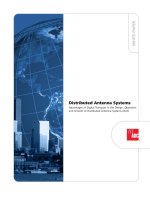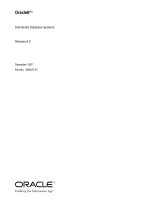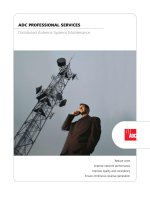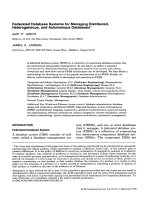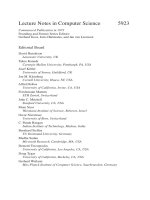Distributed Systems Architectures
Bạn đang xem bản rút gọn của tài liệu. Xem và tải ngay bản đầy đủ của tài liệu tại đây (129.34 KB, 19 trang )
©Ian Sommerville 2004 Software Engineering, 7th edition. Chapter 12 Slide 1
Distributed Systems Architectures
©Ian Sommerville 2004 Software Engineering, 7th edition. Chapter 12 Slide 2
Objectives
To explain the advantages and disadvantages of
different distributed systems architectures
To discuss client-server and distributed object
architectures
To describe object request brokers and the
principles underlying the CORBA standards
To introduce peer-to-peer and service-oriented
architectures as new models of distributed
computing.
©Ian Sommerville 2004 Software Engineering, 7th edition. Chapter 12 Slide 3
Topics covered
Multiprocessor architectures
Client-server architectures
Distributed object architectures
Inter-organisational computing
©Ian Sommerville 2004 Software Engineering, 7th edition. Chapter 12 Slide 4
Distributed systems
Virtually all large computer-based systems
are now distributed systems.
Information processing is distributed over
several computers rather than confined to a
single machine.
Distributed software engineering is therefore
very important for enterprise computing
systems.
©Ian Sommerville 2004 Software Engineering, 7th edition. Chapter 12 Slide 5
System types
Personal systems that are not distributed and that
are designed to run on a personal computer or
workstation.
Embedded systems that run on a single processor
or on an integrated group of processors.
Distributed systems where the system software runs
on a loosely integrated group of cooperating
processors linked by a network.
©Ian Sommerville 2004 Software Engineering, 7th edition. Chapter 12 Slide 6
Distributed system characteristics
Resource sharing
• Sharing of hardware and software resources.
Openness
• Use of equipment and software from different vendors.
Concurrency
• Concurrent processing to enhance performance.
Scalability
• Increased throughput by adding new resources.
Fault tolerance
• The ability to continue in operation after a fault has
occurred.
©Ian Sommerville 2004 Software Engineering, 7th edition. Chapter 12 Slide 7
Distributed system disadvantages
Complexity
• Typically, distributed systems are more complex than
centralised systems.
Security
• More susceptible to external attack.
Manageability
• More effort required for system management.
Unpredictability
• Unpredictable responses depending on the system
organisation and network load.
©Ian Sommerville 2004 Software Engineering, 7th edition. Chapter 12 Slide 8
Distributed systems architectures
Client-server architectures
• Distributed services which are called on by
clients. Servers that provide services are treated
differently from clients that use services.
Distributed object architectures
• No distinction between clients and servers. Any
object on the system may provide and use
services from other objects.
©Ian Sommerville 2004 Software Engineering, 7th edition. Chapter 12 Slide 9
Middleware
Software that manages and supports the different
components of a distributed system. In essence, it
sits in the middle of the system.
Middleware is usually off-the-shelf rather than
specially written software.
Examples
• Transaction processing monitors;
• Data converters;
• Communication controllers.
©Ian Sommerville 2004 Software Engineering, 7th edition. Chapter 12 Slide 10
Multiprocessor architectures
Simplest distributed system model.
System composed of multiple processes
which may (but need not) execute on
different processors.
Architectural model of many large real-time
systems.
Distribution of process to processor may be
pre-ordered or may be under the control of a
dispatcher.
©Ian Sommerville 2004 Software Engineering, 7th edition. Chapter 12 Slide 11
A multiprocessor traffic control system
Traffic lights
Light
control
process
Traffic light control
processor
Traffic flow
processor
Operator consoles
Trafficflowsensorsand
cameras
Sensor
processor
Sensor
control
process
Display
process
©Ian Sommerville 2004 Software Engineering, 7th edition. Chapter 12 Slide 12
Client-server architectures
The application is modelled as a set of
services that are provided by servers and a
set of clients that use these services.
Clients know of servers but servers need not
know of clients.
Clients and servers are logical processes
The mapping of processors to processes is
not necessarily 1 : 1.
©Ian Sommerville 2004 Software Engineering, 7th edition. Chapter 12 Slide 13
A client-server system
s1
s2
s3
s4
c1
c2
c3
c4
c5
c6
c7
c8
c9
c10
c11
c12
Client process
Server process
©Ian Sommerville 2004 Software Engineering, 7th edition. Chapter 12 Slide 14
Computers in a C/S network
Network
SC1SC2
CC1 CC2 CC3
CC5 CC6CC4
Server
computer
Client
computer
s1, s2
s3, s4
c5, c6, c7
c1 c2
c3, c4
c8, c9 c10, c11, c1 2
©Ian Sommerville 2004 Software Engineering, 7th edition. Chapter 12 Slide 15
Layered application architecture
Presentation layer
• Concerned with presenting the results of a computation to
system users and with collecting user inputs.
Application processing layer
• Concerned with providing application specific functionality
e.g., in a banking system, banking functions such as open
account, close account, etc.
Data management layer
• Concerned with managing the system databases.
©Ian Sommerville 2004 Software Engineering, 7th edition. Chapter 12 Slide 16
Application layers
Presentation layer
Application processing
layer
Data management
layer
©Ian Sommerville 2004 Software Engineering, 7th edition. Chapter 12 Slide 17
Thin and fat clients
Thin-client model
• In a thin-client model, all of the application
processing and data management is carried out
on the server. The client is simply responsible
for running the presentation software.
Fat-client model
• In this model, the server is only responsible for
data management. The software on the client
implements the application logic and the
interactions with the system user.
©Ian Sommerville 2004 Software Engineering, 7th edition. Chapter 12 Slide 18
Thin and fat clients
Thin-client
model
Fat-client
model
Client
Client
Server
Data management
Application processing
Presentation
Server
Data management
Presentation
Application processing
©Ian Sommerville 2004 Software Engineering, 7th edition. Chapter 12 Slide 19
Thin client model
Used when legacy systems are migrated to
client server architectures.
• The legacy system acts as a server in its own
right with a graphical interface implemented on
a client.
A major disadvantage is that it places a
heavy processing load on both the server
and the network.
©Ian Sommerville 2004 Software Engineering, 7th edition. Chapter 12 Slide 20
Fat client model
More processing is delegated to the client as
the application processing is locally
executed.
Most suitable for new C/S systems where the
capabilities of the client system are known in
advance.
More complex than a thin client model
especially for management. New versions of
the application have to be installed on all
clients.
©Ian Sommerville 2004 Software Engineering, 7th edition. Chapter 12 Slide 21
A client-server ATM system
Account server
Customer
account
database
Tele-
processing
monitor
ATM
ATM
ATM
ATM

